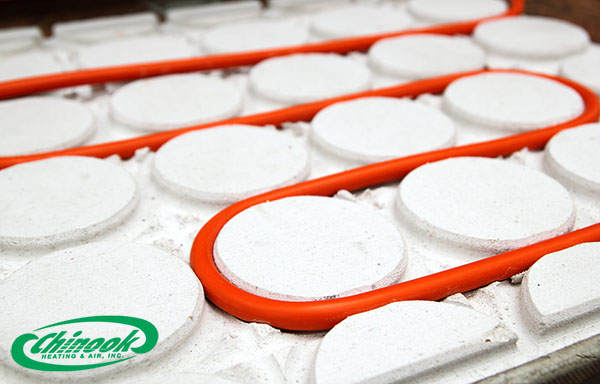There is a little-known sleep hack, that says you should sleep with one or both feet out from under the covers to sleep better; just one more reason to have radiant floor heating. Admit it, you get cold feet getting up in the morning with a cold floor.
What is Radiant Floor Heating?
You may think radiant heating is something new, but it’s been around since the Romans (a long time ago). Radiant heating is a process whereby an object is heated, such as your floor and the heat radiates to warm the overall space. Rooms heated with radiant heat can achieve the same level of comfort as a forced air system at a lower actual room temp.
Radiant heating provides a very broad surface to distribute heat through via coils. It’s typically installed into flooring, but can also be in walls. Three types of radiant heating exist, air-heated radiant flooring, electric radiant flooring and hydronic or liquid radiant flooring system. Hydronic is the most common and efficient, which can be integrated into a larger geothermal system. Radiant flooring provides a quiet, clean warming for not just your space, but your feet!
Heating through the floor, it’s not for everyone
Radiant floor heating isn’t for everyone and you need to define what you consider of value when you weigh your options. Check it out here and use these pros and cons to help:
- Pro: Air is cleaner with a radiant floor heating system. Dust and allergens are not blown around the room as they are with a forced air system.
- Pro: Radiant floor heating is quieter then forced air systems.
- Pro: Operation of a radiant floor heating system is more affordable.
- Pro: Maintenance cost of a radiant floor heating system is less.
- Con: Radiant floor heating systems in existing homes are expensive to install.
- Con: Homes with high ceilings and lots of windows are harder to heat with a radiant floor heating system.
- Con: There is no evidence that having a radiant floor heating system adds any value to your home.
- Con: Repair cost can be extensive as small tubes are run under flooring and in concrete, so access to make repairs is costly.
Radiant heat considerations
While replacing your existing furnace with a radiant system is expensive and difficult, most homeowners opt for radiant heating in a section of the home. If you are remodeling a tiled bathroom or first floor tiled room, radiant can help lower energy costs and keep a room toasty. If you find a section of the house is colder than the rest, radiant heating could be cheaper than expanding ductwork. Also consider radiant for home expansions/additions, although a mini-duct system could be cheaper.
Call Experts in the Tri-Cities on Radiant and Geothermal Heating
Okay, so you’d love to have radiant heated marble tile in your bathroom, but you just can’t afford it. Talk to the guys at Chinook and have them tell you about geothermal units available from American Standard. These units combine the best of forced air and radiant heat to allow more control and efficiency.


